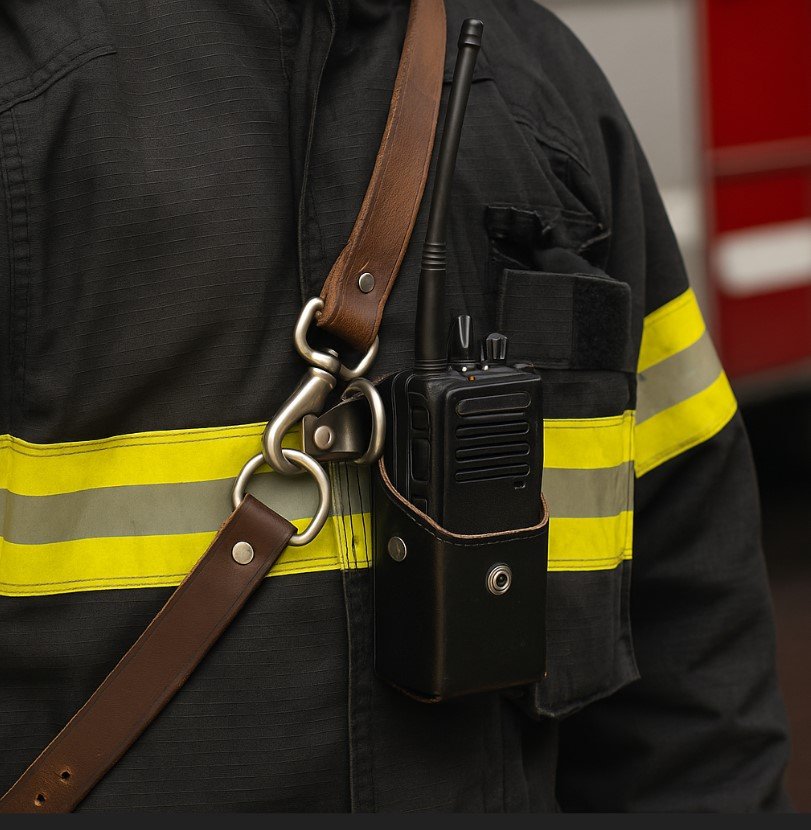Lifestyle
Why Leather Radio Straps Remain a Top Choice for Firefighters

It’s the middle of a structure fire. Visibility is shot. Your hands are full. Every movement is calculated—muscle memory in overdrive.
Now imagine fumbling with a nylon strap that’s soaked, stretched, or singed. You don’t need gear that talks back. You need it to shut up and hold on.
That’s why a leather radio strap hasn’t gone out of style. Not because they look cool (they do), but because they work. And keep working, long after the new materials promise big and deliver meh.
Let’s break down why leather still rides top tier in the firefighting world.
1. Heat Resistance That’s Proven, Not Promised
Synthetic straps may boast high melting points, but leather just… doesn’t melt. Period.
In high-heat conditions, leather holds its form, maintains integrity, and doesn’t degrade the way some synthetic materials can under prolonged exposure. This matters when you’re crawling into heat that scorches your gloves and fogs your mask.
You want a strap that doesn’t flinch under pressure. Leather doesn’t flinch—it firms up.
2. Durability: Built for the Long Haul
Ask around most stations, and you’ll hear about leather straps that have lasted over a decade. Scuffed? Sure. Softened? Definitely. But still dependable?
Every time.
Leather, when properly treated, handles:
- Moisture
- Ash
- UV exposure
- Repeated flexing
- General gear abuse
Unlike lower-end alternatives, leather doesn’t fray, snap, or warp with age — it ages like, well, leather.
3. Comfort That Grows with You
The thing about leather? It breaks in.
What starts as stiff becomes form-fitting. It molds to your shoulder, your movement, your shift rhythms. Over time, a quality leather strap feels more like an extension of your gear than an accessory.
No more awkward pressure points. No more slipping. Just predictable comfort, even on your third call before lunch.
And if you’ve ever worn a cheap strap that digs in or bunches up under your SCBA, you know how big of a deal that is.
4. Aesthetic + Practical = No Compromise
Let’s be honest: leather looks better. There’s a reason ceremonial gear, dress uniforms, and legacy tools feature leather—it carries visual weight. It speaks to tradition, craftsmanship, and utility without flash.
But this isn’t about the show. It’s about clarity. Clean lines, high visibility when needed (thanks to custom reflective add-ons), and an unmistakable sense of professionalism.
In short? Leather means business.
5. Customization Without Gimmicks
Leather offers practical personalization—no gimmicks, just function:
- Adjustable lengths tailored to your body type and turnout gear
- Embossed names, numbers, or unit insignias
- Configurations that match your department’s radio setup
You don’t need 12 clip options or modular add-ons that break after one call. You need clean, smart, dependable custom features that serve your job, not complicate it.
6. Weight Distribution That Works
Here’s a simple truth: leather handles weigh better.
The material disperses the load of your radio evenly across your shoulder and chest. That means less pressure, less shifting, and less fatigue. Especially important when you’re layered up with SCBA, tools, and turnout gear.
Even when soaked, leather maintains its shape and balance. And it doesn’t stretch like synthetic webbing, which leads to bounce and drag.
It’s the little things that save energy over a 12-hour shift. Leather gets that right.
7. Maintenance That’s… Actually Kind of Easy
Waterproof? Not quite. Water-resistant? Absolutely.
Leather radio straps are easy to clean and condition. With basic upkeep—a quick wipe-down here, some leather conditioner there—you’ll keep it pliable and strong for years. No melting, no unraveling, no frayed edges.
And unlike plastic-based materials, you can actually bring leather back from rough conditions with a little care.
8. Trusted by the Veterans (for a Reason)
This one’s intangible—but important.
Veteran firefighters stick with leather not just out of habit, but because it’s stood the test of time. Through fires, floods, vehicle extrications, and wildland calls.
It’s more than a strap. It’s a statement: I take my gear seriously.
There’s a kind of quiet pride in showing up with a strap that’s been through the ringer and still hangs tough. That patina? That wear? That’s not damage—that’s history.
Final Thought
In a world full of lightweight, high-tech, space-age gear, a leather radio strap remains the go-to for one reason: they work.
They don’t promise magic. They don’t come with QR codes or futuristic polymers. They’re just strong, reliable, fire-tested pieces of equipment that show up when you do—and hold fast under pressure.
So the next time someone suggests upgrading to “the latest,” just ask:
Can it take the heat, the sweat, the weight, the wear?
Or is it just trying to look like it can?













